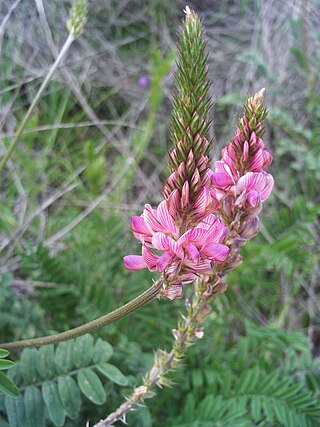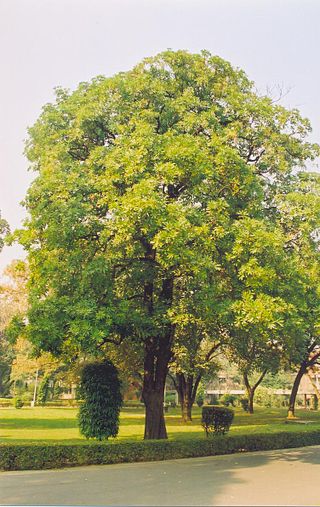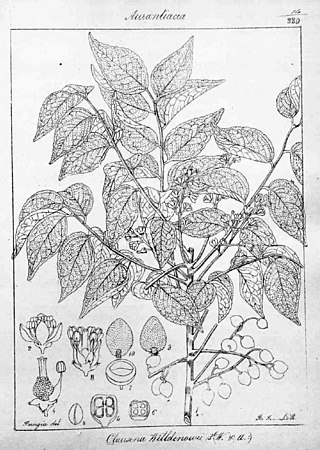
Onobrychis viciifolia, also known as O. sativa or common sainfoin was an important forage legume in temperate regions until the 1950s. During the Green Revolution it was replaced by high yielding alfalfa and clover species. Due to its anthelmintic properties, common sainfoin is a natural alternative to drugs to control nematode parasitism in the guts of small ruminants. This is the main reason why O. viciifolia returned to the scientific agenda in recent years.

Flavonoids are a class of polyphenolic secondary metabolites found in plants, and thus commonly consumed in the diets of humans.

Trematoda is a class of flatworms known as flukes or trematodes. They are obligate internal parasites with a complex life cycle requiring at least two hosts. The intermediate host, in which asexual reproduction occurs, is usually a snail. The definitive host, where the flukes sexually reproduce, is a vertebrate. Infection by trematodes can cause disease in all five traditional vertebrate classes: mammals, birds, amphibians, reptiles, and fish.

Praziquantel (PZQ), sold under the brandname Biltricide among others, is a medication used to treat a number of types of parasitic worm infections in mammals, birds, amphibians, reptiles, and fish. In humans specifically, it is used to treat schistosomiasis, clonorchiasis, opisthorchiasis, tapeworm infections, cysticercosis, echinococcosis, paragonimiasis, fasciolopsiasis, and fasciolosis. It should not be used for worm infections of the eye. It is taken by mouth.

Helminthiasis, also known as worm infection, is any macroparasitic disease of humans and other animals in which a part of the body is infected with parasitic worms, known as helminths. There are numerous species of these parasites, which are broadly classified into tapeworms, flukes, and roundworms. They often live in the gastrointestinal tract of their hosts, but they may also burrow into other organs, where they induce physiological damage.

Fasciolosis is a parasitic worm infection caused by the common liver fluke Fasciola hepatica as well as by Fasciola gigantica. The disease is a plant-borne trematode zoonosis, and is classified as a neglected tropical disease (NTD). It affects humans, but its main host is ruminants such as cattle and sheep. The disease progresses through four distinct phases; an initial incubation phase of between a few days up to three months with little or no symptoms; an invasive or acute phase which may manifest with: fever, malaise, abdominal pain, gastrointestinal symptoms, urticaria, anemia, jaundice, and respiratory symptoms. The disease later progresses to a latent phase with less symptoms and ultimately into a chronic or obstructive phase months to years later. In the chronic state the disease causes inflammation of the bile ducts, gall bladder and may cause gall stones as well as fibrosis. While chronic inflammation is connected to increased cancer rates, it is unclear whether fasciolosis is associated with increased cancer risk.

Fasciolopsiasis results from an infection by the trematode Fasciolopsis buski, the largest intestinal fluke of humans, growing up to 7.5 cm (3.0 in) long.

Ipomoea aquatica, widely known as water spinach, is a semi-aquatic, tropical plant grown as a vegetable for its tender shoots. I. aquatica is generally believed to have been first domesticated in Southeast Asia. It is widely cultivated in Southeast Asia, East Asia, and South Asia. It grows abundantly near waterways and requires little to no care.

Echinococcus granulosus, also called the hydatid worm or dog tapeworm, is a cyclophyllid cestode that dwells in the small intestine of canids as an adult, but which has important intermediate hosts such as livestock and humans, where it causes cystic echinococcosis, also known as hydatid disease. The adult tapeworm ranges in length from 3 mm to 6 mm and has three proglottids ("segments") when intact—an immature proglottid, mature proglottid and a gravid proglottid. The average number of eggs per gravid proglottid is 823. Like all cyclophyllideans, E. granulosus has four suckers on its scolex ("head"), and E. granulosus also has a rostellum with hooks. Several strains of E. granulosus have been identified, and all but two are noted to be infective in humans.

Apios americana, sometimes called the American groundnut, potato bean, hopniss, Indian potato, hodoimo, America-hodoimo, cinnamon vine, or groundnut is a perennial vine that bears edible beans and large edible tubers.

Prof Karl (Carl) Theodor Ernst von Siebold FRS(For) HFRSE was a German physiologist and zoologist. He was responsible for the introduction of the taxa Arthropoda and Rhizopoda, and for defining the taxon Protozoa specifically for single-celled organisms.

Genistein (C15H10O5) is a naturally occurring compound that structurally belongs to a class of compounds known as isoflavones. It is described as an angiogenesis inhibitor and a phytoestrogen.

Alstonia scholaris, commonly called blackboard tree, scholar tree, milkwood or devil's tree in English, is an evergreen tropical tree in the dogbane family (Apocynaceae). It is native to southern China, tropical Asia and Australasia, where it is a common ornamental plant. It is a toxic plant, but is used traditionally for myriad diseases and complaints. It is called 'Saptaparna' in India and is the sacred tree of the 2nd Jain tirthankar Ajitnatha.

Archaeoparasitology, a multi-disciplinary field within paleopathology, is the study of parasites in archaeological contexts. It includes studies of the protozoan and metazoan parasites of humans in the past, as well as parasites which may have affected past human societies, such as those infesting domesticated animals.

Fasciolopsis is a genus of trematodes. They are also known as giant intestinal flukes.
Alpinia nigra is a medium-sized herb belonging to the ginger family. The rhizome is well known in many Asian cultures as a medicinal and culinary item. In many Asian tribal communities it is a part of the diet along with rice.

Flemingia macrophylla is a tropical woody leguminous shrub in the family Fabaceae. It is a multipurpose plant widely used in agriculture, crop improvement, fodder, dyes and for various therapeutic purposes. Perhaps, it is the most versatile species of Flemingia in terms of adaptation, medicinal and agricultural applications.

Clausena anisata (Willd.) Hook.f. ex Benth. is a deciduous shrub or small tree, belonging to the Rutaceae or Citrus family, and widespread in the Afrotropical realm or Sub-Saharan Africa, but absent from the drier regions. It is also found in tropical and South-East Asia, growing in India and Sri Lanka and extending as far as Queensland in north-eastern Australia and some Pacific islands. It is cultivated in Malaysia and Indonesia. As with other plants useful to mankind its large range of medicinal properties has led to a global distribution and its growth wherever the climate is suitable. It grows in higher-rainfall regions in savanna, thickets, riverine forest, disturbed areas and secondary forest, up to an altitude of 3000 m. The leaves, which are foetid when bruised, give rise to the common name 'Horsewood' or the more descriptive Afrikaans common name 'Perdepis', meaning 'horse urine'.

Iris kashmiriana is a plant species in the genus Iris, it is also in the subgenus Iris. It is a rhizomatous perennial, from Kashmir, India. It has straight, sword-shaped, glaucous leaves, tall, thick stem with up 2 short branches, which hold 2–3 flowers, which can be white, cream or pale blue, lilac, lavender or blue-purple. It is cultivated as an ornamental plant in temperate regions, although in Kashmir, it is also planted on graves.

Cat worm infections, the infection of cats (Felidae) with parasitic worms, occur frequently. Most worm species occur worldwide in both domestic and other cats, but there are regional, species and lifestyle differences in the frequency of infestation. According to the classification of the corresponding parasites in the zoological system, infections can be divided into those caused by nematode and flatworms - in the case of the latter, mainly cestoda and trematoda - while other strains are of no veterinary significance. While threadworms usually do not require an intermediate host for their reproduction, the development cycle of flatworms always proceeds via alternate hosts.


















